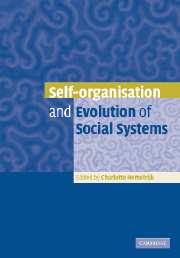Book contents
- Frontmatter
- Contents
- List of contributors
- Preface
- Introduction
- 1 From unicellular to multicellular organisation in the social amoeba Dictyostelium discoideum
- 2 Optimality of communication in self-organised social behaviour
- 3 The interplay of intracolonial genotypic variance and self-organisation of dominance hierarchies in honeybees
- 4 Traffic rules of fish schools: a review of agent-based approaches
- 5 A process-oriented approach to the social behaviour of primates
- 6 Order and noise in primate societies
- 7 Self-organisation in language
- 8 Dictatorship effect of majority rule in voting in hierarchical systems
- 9 Natural selection and complex systems: a complex interaction
- 10 Interlocking of self-organisation and evolution
- Index
- References
5 - A process-oriented approach to the social behaviour of primates
Published online by Cambridge University Press: 07 December 2009
- Frontmatter
- Contents
- List of contributors
- Preface
- Introduction
- 1 From unicellular to multicellular organisation in the social amoeba Dictyostelium discoideum
- 2 Optimality of communication in self-organised social behaviour
- 3 The interplay of intracolonial genotypic variance and self-organisation of dominance hierarchies in honeybees
- 4 Traffic rules of fish schools: a review of agent-based approaches
- 5 A process-oriented approach to the social behaviour of primates
- 6 Order and noise in primate societies
- 7 Self-organisation in language
- 8 Dictatorship effect of majority rule in voting in hierarchical systems
- 9 Natural selection and complex systems: a complex interaction
- 10 Interlocking of self-organisation and evolution
- Index
- References
Summary
Introduction
The marked complexity of primate social behaviour is usually ascribed to the extraordinary intelligence of primates (Whiten and Byrne, 1986, 1997; Byrne and Whiten, 1988). Of the ‘social tools’ adopted by primates various forms of ‘bargaining’ or exchange relationship (such as the interchange of grooming for received support as supposed for chimpanzees) have drawn much attention in both cognitive and evolutionary studies. Exchange relationships are often assumed to account for the occurrence of sociopositive acts, because these acts, such as grooming, food-sharing and support in fights by primates, seem to lower the fitness of the actor and to enhance that of the receiver. The theories that are commonly applied to explain such acts are based on the assumption that the tendency to display non-selfish behaviour (so-called ‘altruism’) is genetically encoded. For each aspect, on the basis of cost–benefit arguments, separate adaptive explanations are given and separate acts are supposed to contribute independently to the fitness of an individual (so that the complete fitness of an individual equals the sum of the contributions of the separate traits). The three main theories are:
The kin selection theory (Hamilton, 1964). Altruism may be spreading evolutionarily if it is directed towards kin, because of the high probability that closely related individuals share the gene responsible for its realisation.
The theory of reciprocal altruism (Trivers, 1971). Altruism can be part of a cooperative relationship, if it is returned by the receiver to the actor. Although the altruist suffers a loss in the short term, by being ‘paid back’ later, he will benefit in the long run.
[…]
- Type
- Chapter
- Information
- Publisher: Cambridge University PressPrint publication year: 2005
References
- 1
- Cited by



